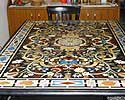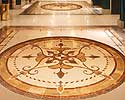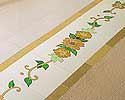| |
Taj Mahal: An Introduction
Taj Mahal, is one of
the most splendid master pieces of architecture in the world.
Located in the city of Agra, in the northern Indian state of
Uttar Pradesh, on the banks of the Yamuna River.. It was
bespoke by the Mughal Emperor Shah Jahan, the son of Jahangir,
as a tomb for his wife, Arjumand Banu Begum, also known as
Mumtaz-ul-Zamani. It took 23 years to complete (1630 - 1653).
Taj Mahal: History
Shah Jahan &
Mumtaz were married in 1612 A.D. The Empress Mumtaz used to go
with her husband in
his military campaigns, and it was in Burhanpur in 1630, that
she gave birth to her last child, after which she died. So in
memory of his wife Mumtaz, he ordered the building of the most
beautiful mausoleum on Earth, THE TAJ MAHAL, one of the
wonders of the earth.
Construction work began in early 1630 and completed in 1648.
All sculptors, masons, craftsmen, and calligraphers were
called from Persia, Ottoman Empire and Europe to make the TAJ
MAHAL a real symbol of Great Emperor Shah Jahan' feelings for
her wife.
The architectural complex of the Taj Mahal comprises of five
main elements:
1) Darwaza or main gateway,
2) Bageecha or
garden,
3) Masjid or mosque,
4) Naqqar Khana or rest house,
5) Rauza or the Taj Mahal mausoleum.
The actual Tomb of Mumtaz is situated inside the Taj. The unique
mughal style
architecture combines elements & styles of Persian, Central
Asian, and Islamic architecture. Most striking are the black
and white chessboard marble floor, the four tall minarets (40
m high) at the corners of the structure, and the majestic
grand dome in the middle. On closer inspection, the lettering
of the Holy Quran verses around the archways appear to be
uniform. The lettering spacing and density has been customized
to give this impression to the viewer. The impressive pietra
dura artwork includes geometric elements & style, plants &
flowers, which are common in Islamic architecture. The level
of sophistication in artwork includes a 3 cm decorative
element containing more than 50 inlaid gemstones.
"The interior of the building is dimly lit through pierced
marble lattices and contains a virtuoso display of carved
marble. Externally the building gains an ethereal quality from
its marble facings, which respond with extraordinary subtlety
to changing light and weather."
鲠Banister Fletcher. A History of Architecture. p624, 630.
Taj Mahal: Architectural
Details
On a platform 22' high and 313' square.
Corner minarets 137' tall.
Main structure 186' on a side, dome
to 187'.
The mausoleum is 57 m (190 ft) square in plan. The central
inner dome is 24.5 m (81 ft) high and 17.7 m (58 ft) in
diameter, but is surmounted by an outer shell nearly 61 m (200
ft) in height.
鲠Banister Fletcher. A History of Architecture. p630.
Specific design credit is uncertain, and is given by different
sources to Istad Usa, Ustad Ahmad Lahori, Isa Muhammad
Effendi, or Geronimo Veroneo. |







